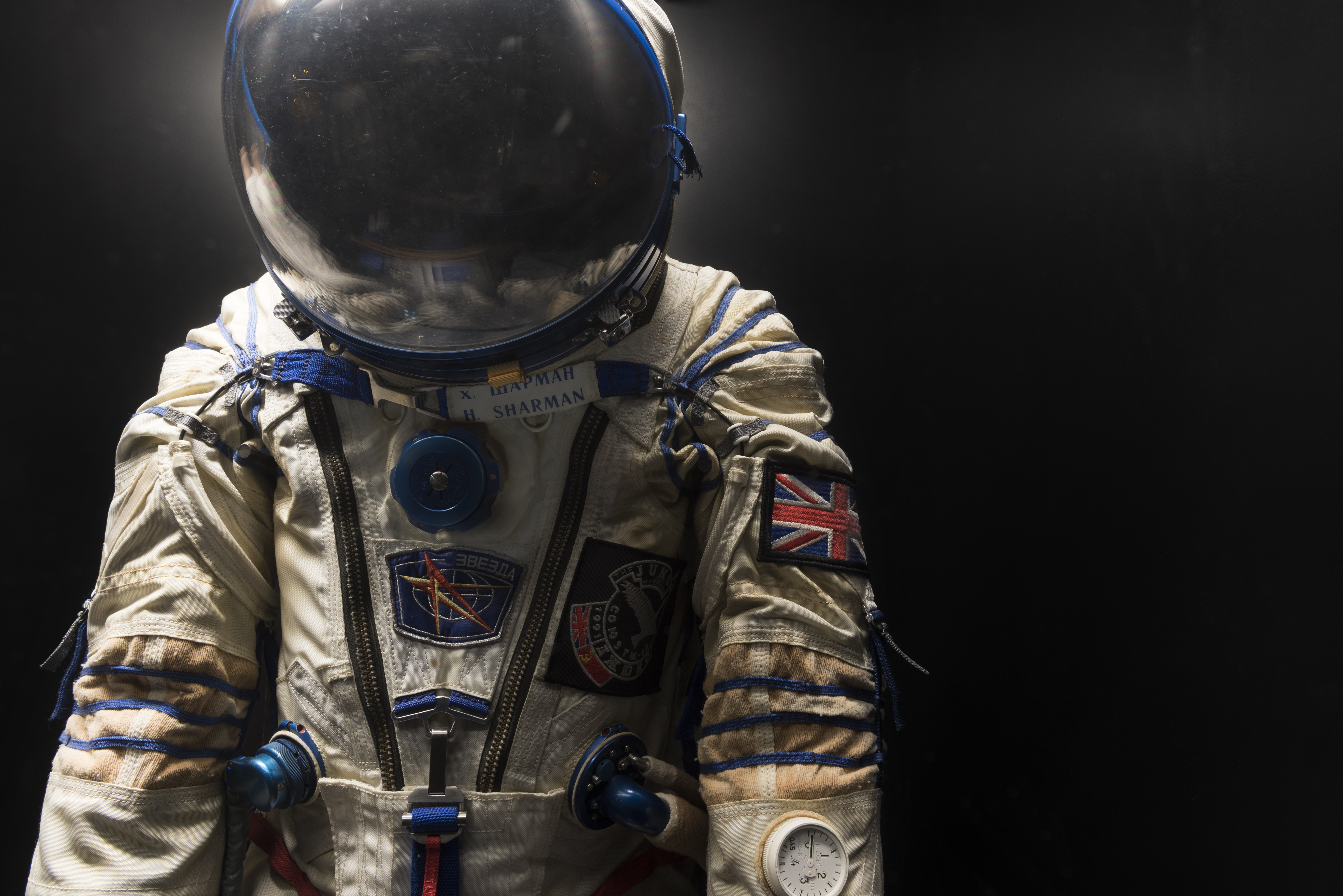During the preparations for our landmark exhibition, Cosmonauts: Birth of the Space Age, we reunited Britain’s first astronaut, Helen Sharman, with her spacesuit around a quarter of a century after she first wore it for her pioneering mission to the Mir space station.
Helen’s journey began in 1989 when she, then a food technologist, answered an advertisement that she had heard on her car radio: “Astronaut wanted. No experience necessary.” With Timothy Mace, she was eventually selected from over 13,000 applicants to represent the British Juno Mission and she spent 18 months training in Star City before she was picked for the launch.
Helen had to endure the centrifuge (to experience g-forces) and hydro tank (for spacewalk training) but was fortunate that her physiology was well suited to these challenges. However, when it came to getting dressed for space she admitted: “Perhaps the greatest discomfort I suffered was doing tests in an off the shelf spacesuit, which was suited to fit a man.”
For Juno, Helen was measured in 54 different places to ensure her Sokol (‘Falcon’) suit was a snug fit and could protect her at the riskiest stages of her mission, where there is a likelihood of cabin depressurization, during take-off, docking, undocking, and landing.

In the Science Museum, we reunited Helen with her spacesuit along with television presenter Dallas Campbell, who is working with filmmaker Chris Riley on a programme about spacesuits. Later I joined them for an event at the Royal Institution, where Cosmonauts curator Doug Millard and conservator Kate Perks also brought along Helen’s radio helmet.
The world’s first spacesuits were developed by the NPP (Research & Development Production Enterprise) Zvezda (‘Star’), which was built in 1952 in the Moscow province of Tomilino and was led for many decades by academician Guy Severin, an expert in developing and creating life-support systems for pilots and cosmonauts. To this very day, every cosmonaut from Yuri Gagarin onwards has passed through this venerable space institution. “The road to the cosmos passes via Zvezda,” explains Severin’s successor, Sergei Pozdnyakov, chief executive and designer.
The world’s first spacesuit, SK-1 – orange, with a white helmet inscribed in red ‘CCCP’ – was worn in the first flight by Gagarin to the sixth by Valentina Tereshkova. Development of the SK-1 by Zvezda began in 1959 but Helen Sharman would wear a later design, the Sokol, which was developed more than a decade later in response to a tragedy.

Pressure suits had been used on the early Vostok space missions, but when the Soyuz spacecraft was being developed in the mid-1960s the controversial decision was taken not to use them on the new spacecraft. That changed after the death in 1971 of the crew of Soyuz-11, Georgi Dobrovolsky, Vladislav Volkov and Viktor Patsaev, who all perished while returning from the Salyut-1 space station when their descent module lost pressure.
Human space flights were temporarily halted and Zvezda designed the new Sokol-K spacesuit within a year. The spacesuit design evolved from the pressure suits worn by the first jet pilots to help them to cope with low pressure and lack of oxygen at high altitudes by supplying their air to them in a person-shaped‚ pressurized bag.
Zvezda replaced the rigid helmet of these jet pilot suits with a soft, non-removable helmet, including a hinged glass visor which could be lifted. To become a space suit they also had to redesign its basic shape. Pozdnyakov explained that, while an aircraft pilot adopts the same position as a car driver, a cosmonaut sits more like “an embryo in the womb”.
The resulting Sokol-K first came into use in 1973. Since its introduction, Zvezda has tweaked the design, trying various different gusset-openings, lacings, separation of the two halves at chest or waist level, and water-cooled emergency suits. In an emergency, it turns out that it is most important to have a spacesuit that can be put on quickly and, by the close of the 1970s, the organisation had essentially settled on today’s model, the Sokol KV-2. “In space travel, it is absolutely essential that all the technology and the systems should be 100% reliable, so that most of our time is spent not so much on developing new things, but on optimizing, perfecting and testing the old,” said Pozdnyakov.
The 22 lb suit consists of an inner layer of rubberised material and outer layer of white nylon. The suit includes the cosmonaut’s feet and its gloves attach by means of blue anodised aluminium wrist couplings. There is a pressure gauge on the left wrist and a mirror on the right to help the cosmonaut see things that would otherwise be outside his or her field of view.
The fundamental design of any spacesuit ultimately depends on its use. For the Buran (‘Snowstorm’) spaceship, cosmonauts would take a more active role, demanding a new kind of spacesuit. The Soviet manned lunar programme required the development of the Krechet (‘Gyrfalcon’) space suit, which had a rigid body with soft sleeves and soft trouser legs. This led to the Orlan (‘Sea-Eagle’) series of semi-rigid spacesuits, used for spacewalks.
The Sokol holds a special place in space culture, remarks Pozdnyakov. Hundreds of these suits have been made over the years. The Sokol “has become a symbol of man’s flight into the cosmos,” he explained in the book to accompany the exhibition. “As the developers, we find it very nice to hear Sandra Bullock, the star of the Hollywood film Gravity, saying that the Russian space suit is a work of art.”
Update: Helen Sharman’s spacesuit is now on display in the Science Museum’s Exploring Space gallery.